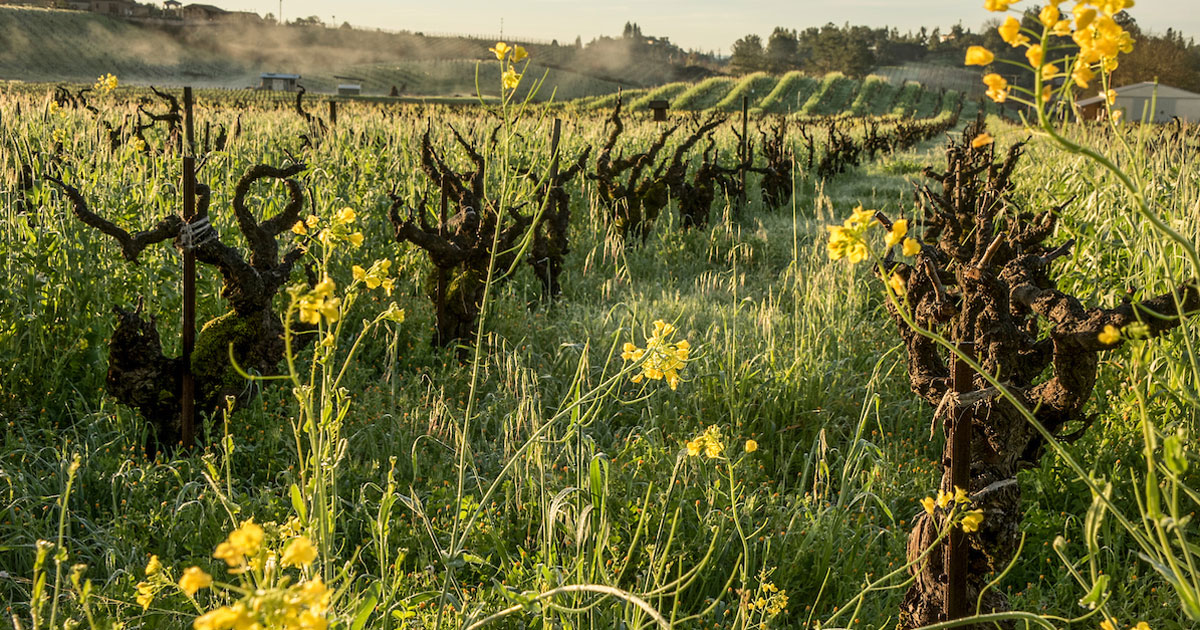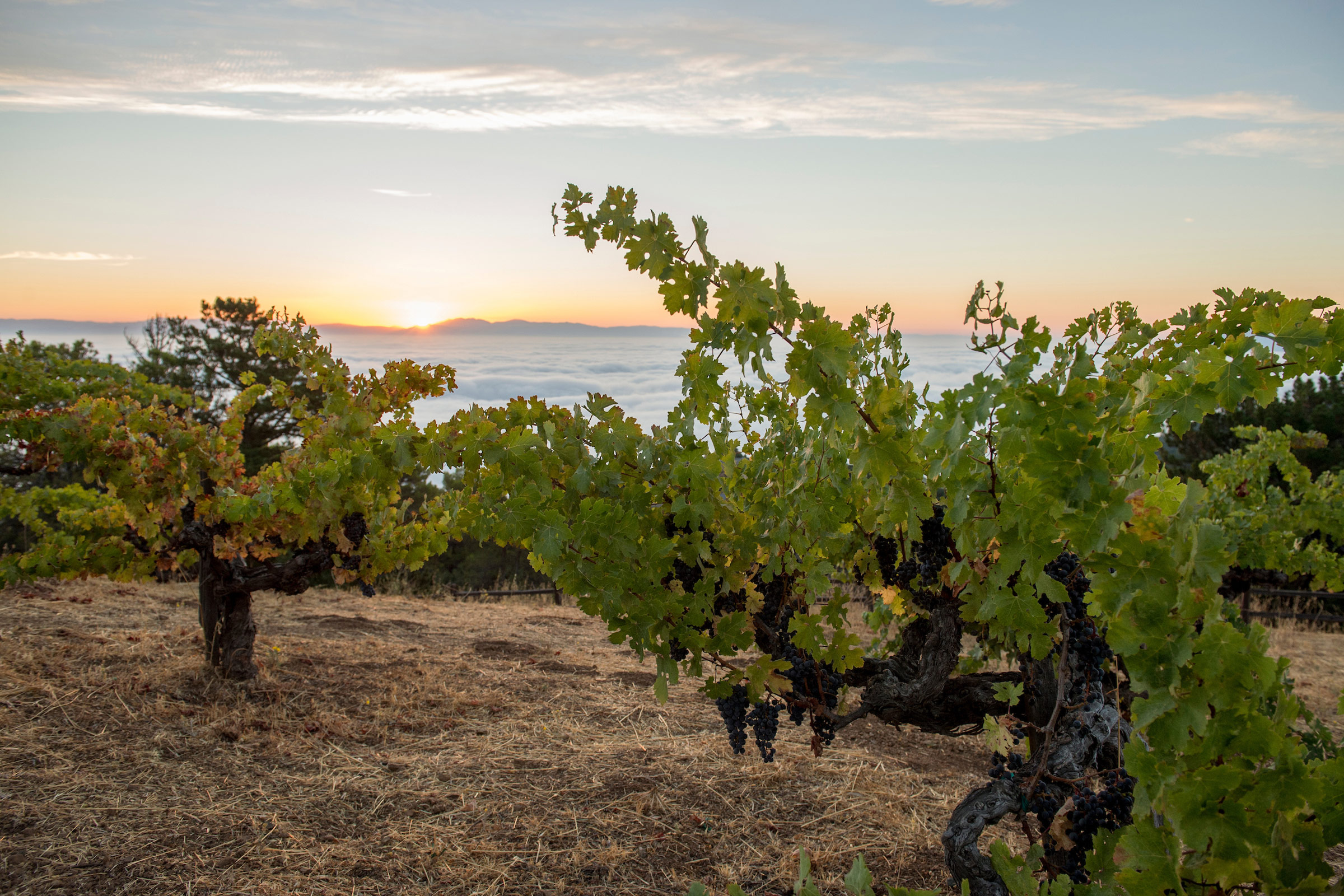Our Transition To Organically Certified Vineyards
Blog Post
In light of our contributions towards moving to organic and sustainable processes, Ridge has been recognized by the United States House of Representatives and the California State Legislature for excellence in water quality improvement and environmental stewardship. So how did we get here? And what are our goals for the future?
David Gates on Going Organic at Ridge
“Ridge began experimenting with organic farming methods in the late 1990s/early 2000s. Through trial and error, in 2008 we began to focus on moving our estate vineyards toward organic certification. To achieve that, you must adhere to the farming standards of the National Organics Program for three transition years. The rules:
- You may use only certified organic pesticides, fertilizers, and other inputs, and keep records of all inputs.
- You must register with, and pay a fee to, the state.
- You must contract with a third-party certifier, who inspects your records and property annually to assure you are complying with National Organics standards.
“In 2011, 76 acres at Monte Bello and 135 acres at Lytton Springs and Geyserville were certified as organic. We decided in 2008 that we wouldn’t place every block on every ranch into transition to organic production. To have done everything at once would have stressed our resources, and could have meant undue risk to the quality of our grapes. Farming organically is more labor-intensive than conventional farming, especially in regard to weed control. We don’t have many more acres to go, but they are the most difficult to convert, because they are on very steep slopes where tilling would make erosion a major concern. Fortunately, a newly-approved organic herbicide may provide the solution. If all goes well, I expect we will be able to certify all of our estate vineyards as organic by 2018-2020.”
-David Gates, Senior Vice President of Vineyard Operations
As of January 2020, Ridge has received organic certification for a collective 345 acres of vines at our Monte Bello, Lytton Springs, Geyserville, and East Bench vineyards.
Sonoma County’s Largest Grower of Organic Grapes
In 2014 Ridge became recognized as the largest grower of organically farmed grapes in Sonoma County, and in the Santa Cruz Mountains appellation.

This information was reported by Pam Strayer, and resulted from research for her new software applications. The information served to remind us of the significant commitment we have made to organic farming.
Paul Draper on the Benefits of Organic Farming
“We decided to farm organically because we believe it leads to better grapes and higher quality wines. True organic farming focuses attention on the health of each individual vine, and on the soil’s microbiological life. We are stewards of the land; farming organically is the right thing to do—for our employees, the community, and for future generations. This approach in the vineyard, plus our traditional approach to winemaking, will provide the finest possible wines for our customers.”
-Paul Draper, Chairman of the Board
Current Organic Processes at Ridge Vineyards
Ridge currently practices organic and sustainable farming in a number of ways. These include the following:

1. Compost
We compost all our grape stems and pomace (fermented skins and seeds) at both wineries, along with our neighbors’ horse manure. After a year this “black gold” is spread on our vineyards after harvest and helps feed our soil and our vines.
2. Cover Crops
We use several different cover crops depending on each vineyard block. These include soil-building legume and grass mixes that add nitrogen and organic matter to keep vines healthy; plantings to increase the population of beneficial insects; grasses and clovers for erosion control; and deep-rooted perennial grasses to control vine vigor in excessively fertile soils.
3. Water Conservation & Recycling
We look to conserve water in a variety of ways, including monitoring our vineyards at the vine level with the latest sensor technology to make sure that any irrigation we do is necessary.
4. Low / No Tillage
We practice no till (mow only) on our hillside vineyard blocks to help minimize erosion and build organic matter in the soil. In blocks where the vines need some nitrogen help we mow alternate rows to keep them in permanent cover.
5. Use of Hedgerows
Hedgerows in vineyards help harbor and expand beneficial insect populations, provide shelter for animals, shade for waterways, fix carbon from the atmosphere, and break up the monoculture of vineyards.
6. Focus on Old Vines
We value old vines (more than 50 years old) for a variety of reasons. Most importantly, they usually make great wines.
7. Integrated Pest Management (IPM)
We use IPM practices for insect and disease management. IPM is a systems approach to pests and diseases that combines a wide array of farming practices, with careful monitoring of pests and their natural enemies to prevent crop damage.
8. Insects
Instead of spraying to control vine-damaging spider mites, we use beneficial insects to reduce their populations to insignificant levels.
9. Birds
We use raptor roosts and bird boxes to help with insect and rodent control. Every winter after the birds have migrated south, we maintain and clean the boxes to ensure their use by wildlife the following season.
10. Vine Balance
We constantly work toward achieving vine balance, essential to producing flavorful wines of distinction and longevity. Ultimately, balance is assessed on a vine-by-vine basis in order to meet our high standards for fruit quality.
11. Education
Our commitment to sustainable farming leads to our involvement in several organizations that foster new ideas about agriculture and environmental stewardship.
Wait!
In order to qualify for user related discounts, you must log in before proceeding with checkout. Click the button below to log in and receive these benefits, or close the window to continue.
Log In